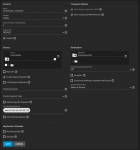Hi,
Right now I'm using an external USB disk for backup (ZFS replication), but once in a while if there are power interruptions the pool sees corruption. I was wondering if there is any better alternative than building a whole separate NAS. Yes, my personal data is precious to me, but surely there's a better more cost-effective solution.
One thing I was wondering about was eSATA. Can I connect a disk externally with eSATA? Would that be acceptable? If not, I'm 100% out of SATA ports on my motherboard, and I have 1 or 2 2.5" bays in my case I could use... but I'd need some kind of PCIe SATA card.
Preferably I'd like an external solution so I can pull the drive off if there's a fire or something and run with it :).
Right now I'm using an external USB disk for backup (ZFS replication), but once in a while if there are power interruptions the pool sees corruption. I was wondering if there is any better alternative than building a whole separate NAS. Yes, my personal data is precious to me, but surely there's a better more cost-effective solution.
One thing I was wondering about was eSATA. Can I connect a disk externally with eSATA? Would that be acceptable? If not, I'm 100% out of SATA ports on my motherboard, and I have 1 or 2 2.5" bays in my case I could use... but I'd need some kind of PCIe SATA card.
Preferably I'd like an external solution so I can pull the drive off if there's a fire or something and run with it :).


